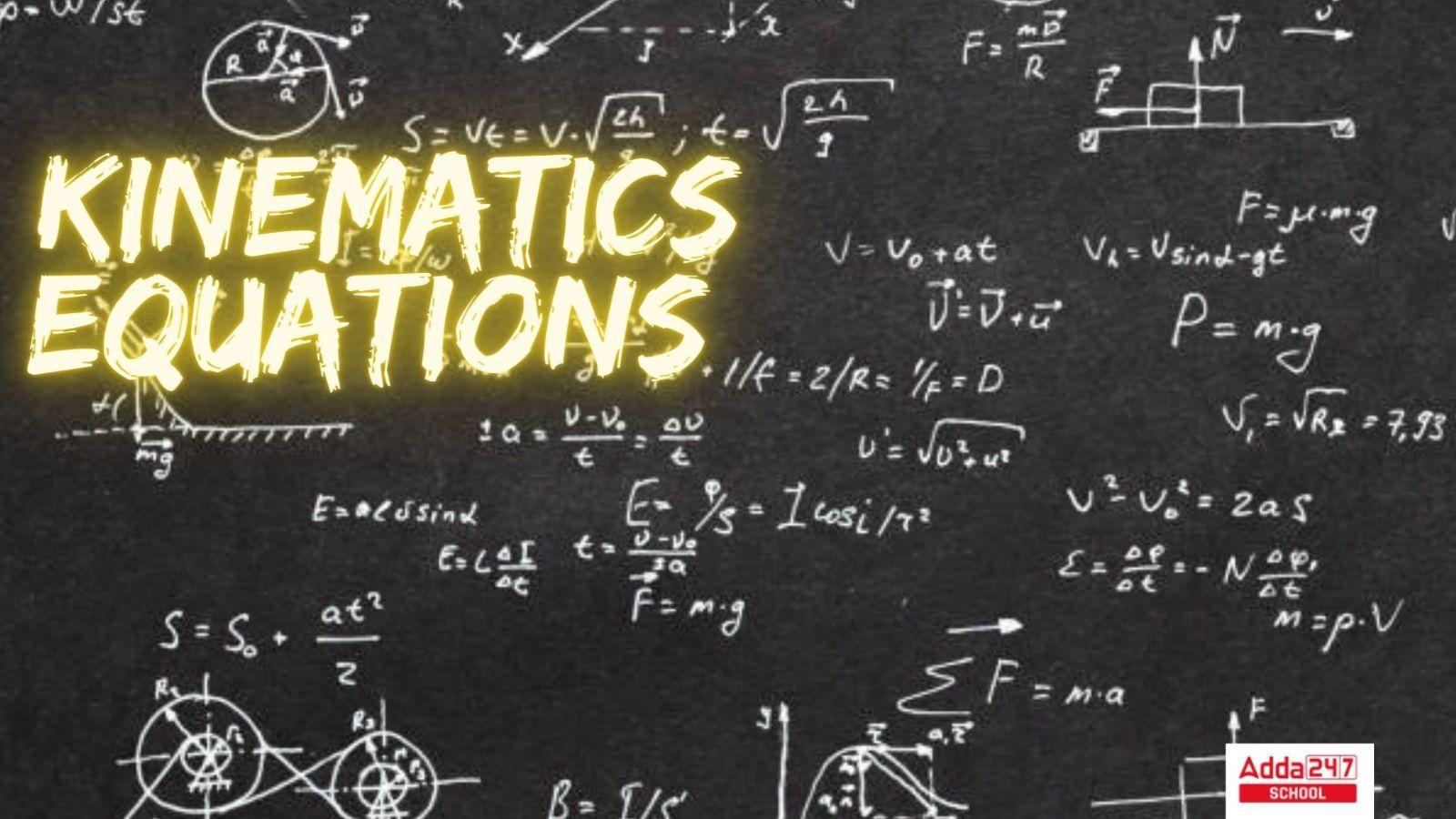Table of Contents
Kinematic Equations
Kinematics Equations: Kinematics Equations are very important in the field of physics. These equations can be used to describe the motion of any object in terms of its position, velocity, and acceleration. Generally, this equation is most used in the field of engineering, and that is why students want to get more and more information about Kinematics Equations.
But in standard books, it has been explained in such a standard way that a student may face a lot of difficulty in understanding it. Therefore, in today’s article, we have provided you with all the information regarding the use and construction of Kinematics Equations with explanations in the simplest languages. If you also want to get all the information regarding Kinematics Equations, then stay with us till the end of today’s article.
What are Kinematics equations?
Kinematics Equations are a set of mathematical equations used to describe the motion of an object in terms of its position, velocity, and acceleration. Under this, the force is not taken into account, which is the root cause of the motion. These equations link together five kinematic variables, including displacement (Δx), initial velocity (v0), final velocity (v), time interval (t), and constant acceleration (a). Using these equations, we can calculate one or more of these four.
If the other four are known that allows us to determine different aspects of an object’s motion. Kinematics equations are widely used in the field of physics to describe the motion of objects in various contexts such as free fall, projectile motion, and circular motion.
Basic kinematics equations
These are the four basic kinematics equations:
- First basic kinematics equation:
v=v0+at
- Second basic kinematics equation:
x=(v+v02)t
- Third basic kinematics equation:
x=v0t+12at2
- Fourth basic kinematics equation:
v2=vo2+2ax
Variables of Kinematics Equations
- Displacement (Δx): the change in position of the object from its initial position to its final position.
- Initial velocity (v0): The velocity of the object at the beginning of its motion.
- Final velocity (v): the velocity of the object at the end of its motion.
- Time interval (t): the duration of the motion of the object.
- Constant acceleration (a): the rate at which the object’s velocity changes over time, which is assumed to be constant in Kinematics equations.
Derivation of Kinematics equations
The derivation of Kinematics Equations involves analyzing the motion of an object under constant acceleration. This is done using basic principles of calculus, and the definitions of velocity and acceleration. Here is a step-by-step derivation of the Kinematics equations:
Assuming constant acceleration (a), we can use the definition of acceleration to write:
a = dv/dt
where v is the velocity of the object and t is time.
We can integrate both sides of this equation concerning time to get:
∫a dt = ∫dv
Integrating the left side gives:
at + C1 = v
where C1 is the constant of integration.
Using the definition of velocity, we can write:
v = dx/dt
where x is the displacement of the object.
Substituting v with at + C1, we get:
dx/dt = at + C1
We can integrate both sides of this equation concerning time to get:
∫dx = ∫at + C1 dt
Integrating the left side gives:
x = C2 + at^2/2 + C1t
where C2 is the constant of integration.
Now, we can use the initial conditions of the object’s motion to solve for the constants C1 and C2. Let x0 be the initial position of the object and v0 be its initial velocity at time t = 0. Then:
x0 = C2
v0 = C1
Substituting these values into the equation for x, we get:
x = x0 + v0t + (1/2)at^2
This equation relates the displacement of an object to its initial position, initial velocity, acceleration, and time interval. We can also use the equations we derived earlier to express the final velocity of the object in terms of its initial velocity, acceleration, and time interval:
v = v0 + at
These equations, together with the equations for acceleration and velocity, form the set of Kinematics equations.
Kinematics Formulas Sheet
formulas sheet for basic kinematics, which deals with the motion of objects without considering the causes of that motion (e.g., forces). These formulas are typically used in introductory physics courses:
1. Displacement (Δx):
- Δx = V₀t + (1/2)at²
- Δx = (V₀ + V)t/2
2. Average Velocity (V_avg):
- V_avg = Δx / Δt
3. Instantaneous Velocity (V):
- V = dΔx / dt
4. Average Speed (S_avg):
- S_avg = Total distance traveled / Total time taken
5. Acceleration (a):
- a = ΔV / Δt
6. Kinematic Equation (No Initial Velocity):
- Δx = (1/2)at²
7. Kinematic Equation (No Acceleration):
- Δx = V₀t
8. Kinematic Equation (No Time):
- V² = V₀² + 2aΔx
9. Kinematic Equation (No Final Velocity):
- Δx = V₀t + (1/2)at²
10. Kinematic Equation (No Displacement): – V = V₀ + at
11. Kinematic Equation (Final Velocity Squared): – V² = V₀² + 2aΔx
12. Free Fall (Gravity Near Earth’s Surface): – g ≈ 9.81 m/s²
13. Free Fall (Vertical Motion): – Δy = V₀t + (1/2)gt²
14. Free Fall (Final Velocity): – V = V₀ + gt
These formulas can be used to solve a wide range of problems related to the motion of objects in one dimension. Just make sure to use the appropriate formula for the given situation and plug in the values you know to calculate the unknowns. Additionally, keep track of units to ensure your calculations are consistent.
Difference between Kinematics and Dynamics equations
Kinematics and Dynamics are two important branches of Physics, which deals with the motion of objects. But they have different focuses and use different sets of equations. Here we have listed below 10 differences between Kinematics and Dynamics Equations-
- Focus: Kinematics focuses on describing the motion of an object in terms of position, velocity, and acceleration, without considering the forces that can cause motion. Whereas Dynamics focuses on the relationship between the motion of an object and the forces that cause it
- Equations: Kinematics Equations describe motion in terms of displacement, initial velocity, final velocity, time interval, and constant acceleration. Whereas Dynamics Equations describe motion in terms of force, mass, and acceleration.
- Derivation: Kinematics Equations are derived from the analysis of motion without considering the forces that cause it. Whereas Dynamic Equations are derived from Newton’s laws of motion which tell us how the motion of an object changes in response to external forces.
- Applications: Kinematics Equations are used to solve problems related to the motion of an object. For example, determining the distance covered or the time taken to cover a certain distance. Dynamic equations are used to solve problems related to forces acting on an object. For example, calculating the force required to move an object.
- Variables: Kinematics Equations relate 5 variables together, whereas Dynamics Equations relate three variables together.
- Types of Motion: Kinematics Equations can describe different types of motion, such as linear motion, circular motion, and projectile motion. But dynamic equations are only used to describe the motion of an object in response to external forces.
- Forces: Kinematics Equations do not take into account the forces acting on an object, while Dynamic Equations describe the forces acting on an object, which can affect its motion.
- Units: The units of measurement used for Kinematics Equations are different from those used for Dynamic Equations.
- Predictive Ability: Kinematics Equations can predict the future motion of an object given its initial position, while Dynamic Equations can predict the future motion of an object given its initial position and forces acting on it.
- Real-Life Examples: Kinematics Equations are often used in real-life examples such as determining the speed of a car, while Dynamics Equations are used in engineering applications.
How do Kinematics equations relate to the motion of an object?
Kinematics Equations are used to describe the motion of an object in terms of its position, velocity, and acceleration. These equations provide a mathematical framework for computing unknown aspects of an object’s motion based on unknown variables.
For example – we know the initial velocity, final velocity, and time interval of an object, then we can use Kinematics Equations to calculate the displacement traveled by the object during that time.
Similarly, if we know the displacement, initial velocity, and time interval of an object, then we can calculate its final velocity. Kinematics Equations enable us to provide a systematic way of computing the unknown variables of motion of an object and to describe different types of motion such as free fall projectile motion and circular motion.
Significance of Kinematics equations in the field of physics
Kinematics equations are essential in the field of physics because they provide a mathematical framework for describing the motion of objects. They are particularly useful in analyzing the motion of objects under constant acceleration, which is a common scenario in many physical systems.
Kinematics equations allow us to calculate various aspects of the motion of an object, such as its velocity, displacement, and acceleration at certain initial conditions, and are important in the study of mechanics, which is the branch of physics that deals with the motion of objects and the forces that produce them.
What are some real-life examples of Kinematics equations?
Kinematics Equations can be applied to many real-life introductory topics, such as the motion of a car on a highway, the motion of a ball thrown in the air, and the motion of a satellite with respect to earth.
These can be used to base engineering applications such as designing rockets, and projectiles, or calculating trajectories. Within sports, Kinematics Equations can be used to analyze the motion of athletes, such as during a race. Sprinter’s speed, or the speed of a diver during a dive.
What is the role of time interval in Kinematics equations?
The role of time interval in Kinematics Equations is very important because it determines the period of motion of an object. The time interval is usually denoted by the variable “t” and is measured in seconds. Knowing the time interval and other initial conditions such as initial position, velocity, and acceleration of objects, we can use Kinematics Equations to calculate various aspects of motion.
For example, the time interval is important in determining the rate of change of these variables of initial position, velocity, and displacement time, which can be described by the acceleration of the object.
How is constant acceleration related to Kinematics equations?
Constant acceleration is a common phenomenon in many physical systems and is related to the Kinematics Equations in that they are specifically designed to describe the motion of objects under constant acceleration. Constant acceleration means that the description of the object is uniform and does not change with time.
This allows us to use Kinematics Equations to calculate various aspects of an object’s motion such as its final position and displacement. Examples of constant acceleration include free-fall motion, projectile motion, and circular motion.





 NEET UG 2025: Is NEET Previous years Que...
NEET UG 2025: Is NEET Previous years Que...
 JEE Mains Session 2 Result 2025 OUT, Sco...
JEE Mains Session 2 Result 2025 OUT, Sco...
 TS Inter Results 2025 Date for TSBIE 1st...
TS Inter Results 2025 Date for TSBIE 1st...










